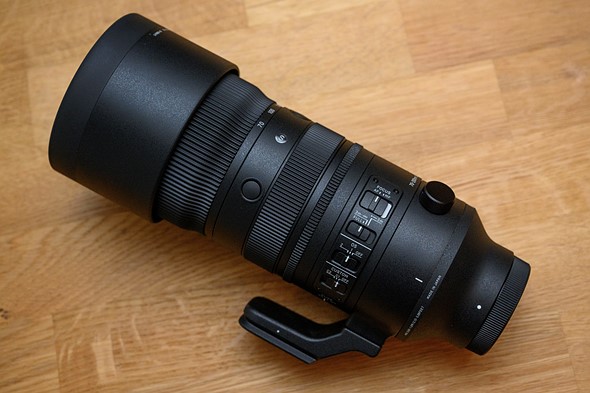Sigma 70-200mm DG DN OS | Sports initial impressions
 |
Product photos: Carey Rose
Sigma's latest release, the 70-200mm F2.8 DG DN OS | Sports, provides a new constant-aperture telephoto zoom for users of Sony, Panasonic, Leica and Sigma full-frame mirrorless cameras. The lens itself isn't much of a surprise, what with the existing 'pre-announcements' that have been floating around the web for a while now, but we've been able to get our hands on a copy to shoot some samples, to get an idea of how it stacks up against the existing first- and third-party competition.
Buy now:
Key specifications:
- Focal length: 70-200mm (105–300mm with APS-C crop)
- Aperture range: F2.8 – F22
- Stabilization: Yes
- Filter thread: 77mm
- Close focus: 0.65m (25.6") at 70mm; 1m (39.4") at 200mm
- Maximum magnification: 0.19x (at 70mm)
- Diaphragm blades: 11
- Hood: Included
- Weight: E-mount 1335g (2.94 lb); L-mount 1345g (2.96 lb)
- Optical construction: 20 elements in 15 groups (6 FLD, 2 SLD, 3 aspherical)
The lens comes with a recommended price of $1499, which represents a fair discount from most camera maker's own options, and Sigma says it will be available on December 7, 2023.
Handling and build
At nearly one-and-a-half kilos (∼three pounds), the Sigma 70-200mm DG DN OS is no lightweight, but it does feel lighter than you might expect given its dimensions and capability. It also balances well on the a7R V that we've had it mounted to.
 |
|
It's no lightweight, but it's not really a heavyweight, either. |
Build quality is just about faultless. The exterior is a mix of textured high-quality polycarbonate and metal, and the ribbed zoom, focus and aperture rings are easy to find by feel. The aperture ring is particularly well-executed. It allows for both clicked- and clickless operation, and it can be locked in either 'A' (which, depending on your shooting mode, passes aperture control off to a command dial or the camera's autoexposure algorithm), or it can be locked out of A, meaning you can use the ring to freely select your exposure, but you won't accidentally override the ring with an overly enthusiastic adjustment.
There are switches aplenty, including a C1-C2 switch for selecting between two sets of optical stabilizer or focus limiter settings (though this is an L-mount-only feature requiring Sigma's UD-11 USB dock). There is also a three-setting focus limiter (Full, 3m–infinity, minimum distance–3m), an autofocus selector and the aforementioned aperture click and lock controls. Finally, there are three programmable pushbuttons on the barrel between the zoom and focus rings; one on the top of the lens, one on the bottom and one on the left as you are looking down the barrel towards your subject. But keep in mind that though there are three buttons, you can only program a single function for them (at least, that's the case on our Sony a7R V).
 |
| An Arca-Swiss cutout on the tripod foot is always a nice touch. |
For the tripod enthusiasts among you, the (included) tripod foot comes with an Arca-Swiss dovetail cutout and the tripod collar has nice, pronounced detents at each 90-degree rotation. And for the video shooters among you, you'll be happy to know that zooming the lens doesn't meaningfully change the overall weight distribution, so you can zoom away even while shooting on a balanced gimbal.
 |
| This overlap (full zoom ring shown on left side, hood overlap shown at right) proved to be irksome for me, but your mileage may vary. |
If there's one concern we have with the handling of the Sigma 70-200mm DG DN OS, it's with the included lens hood. The build of the hood itself is fantastic, constructed out of carbon-fiber reinforced plastic and it secures to the lens with a textured thumb screw. The problem is that, when it's mounted in the shooting position, it covers 3–4mm of the front edge of the zoom ring. That may not sound like a lot, and to be sure, there's still plenty of ring to grab onto, but nonetheless, my hand kept running into the hood as I was going to adjust the zoom setting. This may be something that clears up with prolonged usage and muscle memory, however.
Image quality and autofocus impressions
While we need to reserve final judgment of the lens' optical characteristics until we've had time to do more formal testing, our initial impressions are largely positive. While the lens is certainly sharp enough at F2.8 on the 61MP sensor of the a7R V, particularly for portraits, you will find that stopping down to F4 and F5.6 will get you greater clarity for landscapes and the like. Vignetting is present but is pretty subtle even at F2.8.
We found the bokeh (characteristics of out-of-focus regions of the image) to be pretty smooth and rarely distracting, even with busier backgrounds and more moderate apertures. However, if you're not a fan of the cat-eye effect of out-of-focus highlights, you'd best steer clear – the effect can be very pronounced at wider apertures. Shooting into the sun can induce a slight loss of contrast, but we didn't find it to be extreme, and chromatic aberrations are very well controlled indeed. We'll be looking more closely at sunstars and flare when the sun emerges for more than a few moments at a time here in the Seattle region.
 |
|
A fast 70-200mm lens isn't just for outdoor use, either. Sony a7R V | Sigma 70-200mm F2.8 @ 173mm | ISO 800 | 1/200 sec | F2.8 |
Autofocus speeds are quick, and though they're not as close to instantaneous as some other options on the market, we don't think you'll have trouble tracking most any moving subject. We'll need more sporting opportunities to know for sure. The manual focus ring is wonderfully damped, and focus breathing is well-controlled across the zoom range, so this is shaping up to be a solid option for video shooters interested in this focal range.
Sample gallery
Please do not reproduce any of these images on a website or any newsletter/magazine without prior permission (see our copyright page). We make the originals available for private users to download to their own machines for personal examination or printing (in conjunction with this review); we do so in good faith, so please don't abuse it.
Takeaways
Overall, the Sigma 70-200mm DG DN OS | Sports is a welcome addition to the constant-aperture telezoom market. It's not the absolute sharpest option on the market, nor is it the lightest, but between its excellent build quality, impressive aberration control and relatively reasonable price, we think photographers will find a lot to like here.
Is the Sigma 70-200mm DG DN OS going to find a place in your camera bag? What do you make of Sigma's latest telezoom release? Let us know in the comments.
Buy now:





























































Comments